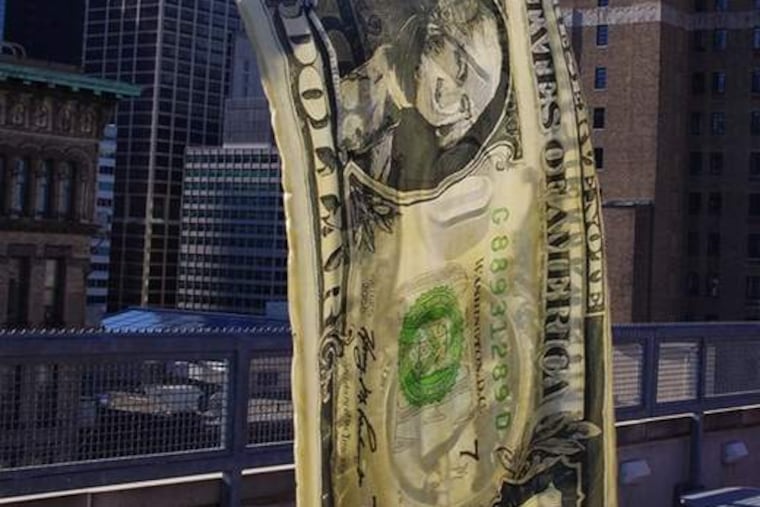Little Berlin show devoted to art and writing
Check your literal-mindedness at the door. "Reading Room: Intersections Between Art & Writing," a group show organized by Becky Huff Hunter for Little Berlin, reveals itself slowly. Eventually, though, the boundaries between the two mediums of expression begin to blur — and fascinatingly so. Artists can be strikingly original writers and vice versa. If you remember the Narrative Art movement that grew out of Conceptual Art and had its heyday in the 1970s — and counted William Wegman, Bill Beckley, and Peter Hutchinson among its ranks of storytelling artists — you're a step ahead of the game. I walked around the gallery in an orderly fashion with a checklist, but you can dive in anywhere — in hindsight, I think that's the logical approach to an exhibition as open and freewheeling as this one.

Check your literal-mindedness at the door. "Reading Room: Intersections Between Art & Writing," a group show organized by Becky Huff Hunter for Little Berlin, reveals itself slowly. Eventually, though, the boundaries between the two mediums of expression begin to blur — and fascinatingly so. Artists can be strikingly original writers and vice versa. If you remember the Narrative Art movement that grew out of Conceptual Art and had its heyday in the 1970s — and counted William Wegman, Bill Beckley, and Peter Hutchinson among its ranks of storytelling artists — you're a step ahead of the game.
I walked around the gallery in an orderly fashion with a checklist, but you can dive in anywhere — in hindsight, I think that's the logical approach to an exhibition as open and freewheeling as this one.
At first, the show seems enormous, and in a sense it is, if you count the pages, booklets, and books by about 20 writer-artists dispersed throughout the gallery and arranged in a section with seating designated as a reading room, and then in what constitutes the more conventionally "art" part, of works (all thoroughly unconventional) by Gillian Allnutt, Anthony Boswell, Emily Erb, Carol Mavor, and Tamarin Norwood. Plan on spending at least an hour here if you want to read some of the texts that Hunter has made available, which include writings by Hermann Hesse, Agnes Martin, Howard Nemerov, and Gertrude Stein, among others. A second visit may be called for.
Over two visits to Little Berlin, I was drawn back to the same works, all of them the most obvious hybrids of art and words: Erb's incredibly detailed embroidered maps on silk, in particular her representation of the Pennsylvania Railroad's complex network of rail lines and connections across the United States, which appears to have been based on an early 20th-century map produced by the railroad; videos of Norwood's hyperactive, slightly loony monologues, which are reminiscent of Spalding Gray's performances; and Mavor's hauntingly beautiful film, Fairy Tale Still Almost Blue: She Writes with the Blue-Blood of a (Swan-like) Goose, narrated in her own hypnotic voice, which is something akin to an all-female, fairy-tale version of Thomas Mann's dark novella Death in Venice.
An Ingram retrospective
Clearly, Judith Ingram was one of those artists who are possessed by everyday materials and the magic that might be made of them.
Over a career that spanned five decades, Ingram, who died in April at 85, never stopped working, experimenting, and learning. If there was a technique that would afford a new development in her art, Ingram, who did not have an art school education, would find the class or workshop she needed to move ahead. A retrospective of her work at the Rosenfeld Gallery reveals Ingram's forward momentum and embrace of change, qualities that might ordinarily be obscured by the sense of quiet self-possession that many of her pieces project.
Ingram's show begins with the representational color woodcuts she made in the early 1960s, which seem to be influenced by German expressionism, then moves on to her abstract color woodcuts of the early 1970s. By the mid-'70s, though, Ingram learned to make her own paper, and the results are original and whimsical, as in Summer Smoke (1982), in which a piece of creamy white handmade paper acts almost like a petticoat or window shade over an inner layer of shredded paper, and Impostors (date unknown), a group of 15 painted cast-paper "bricks" mounted together on the gallery's white wall that look exactly like a section of brick wall. The nuances in the colors of each brick are eerily true to life (this piece made me think of certain works by Bill Walton, but Walton would have used real bricks).
In the 1990s, Ingram began making small mixed-media constructions of wood, metal screening, and wire that suggest talismans and memento mori and were likely inspired by her travels in Mexico. The final works of this show, made in 2003 (Ingram turned to writing poetry over the last eight years of her life), are a group of small mixed-media constructions on wood reminiscent of icons. In between all of this, Ingram also made enormous (but incredibly light in weight) cast-paper sculptures that look vaguely like trees and tiny cast-paper tabletop sculptures that could pass for relics from an ancient culture.
Ingram's devotion to art was not limited to her own. In the back room, gallery owner Richard Rosenfeld has installed Ingram's collection of works by Robert Motherwell, Edna Andrade, and other artists she admired.